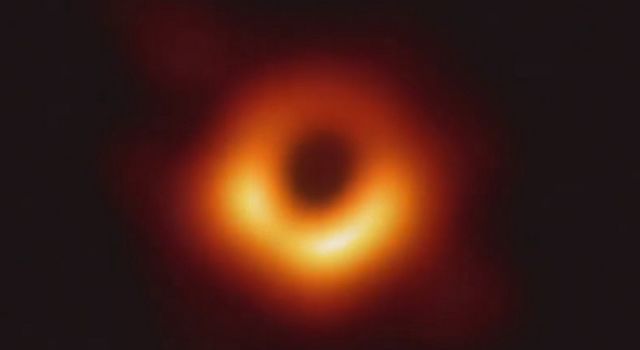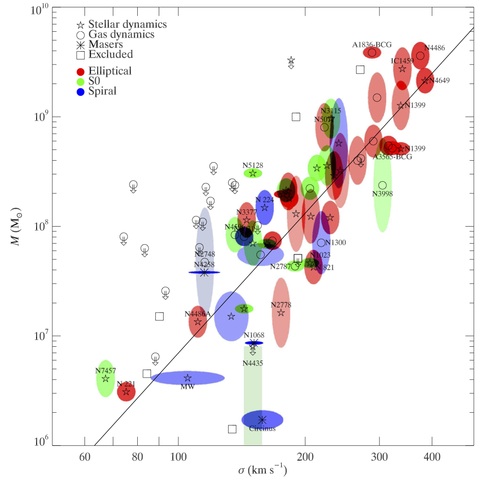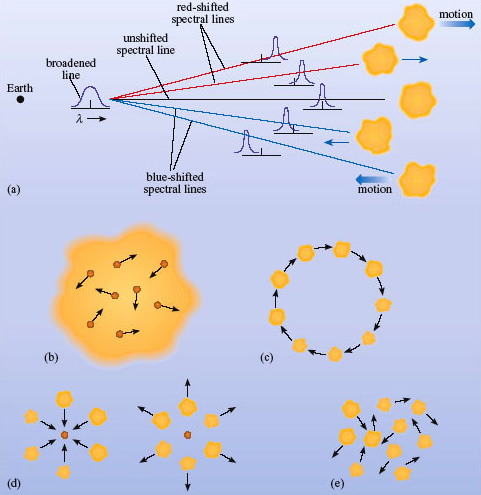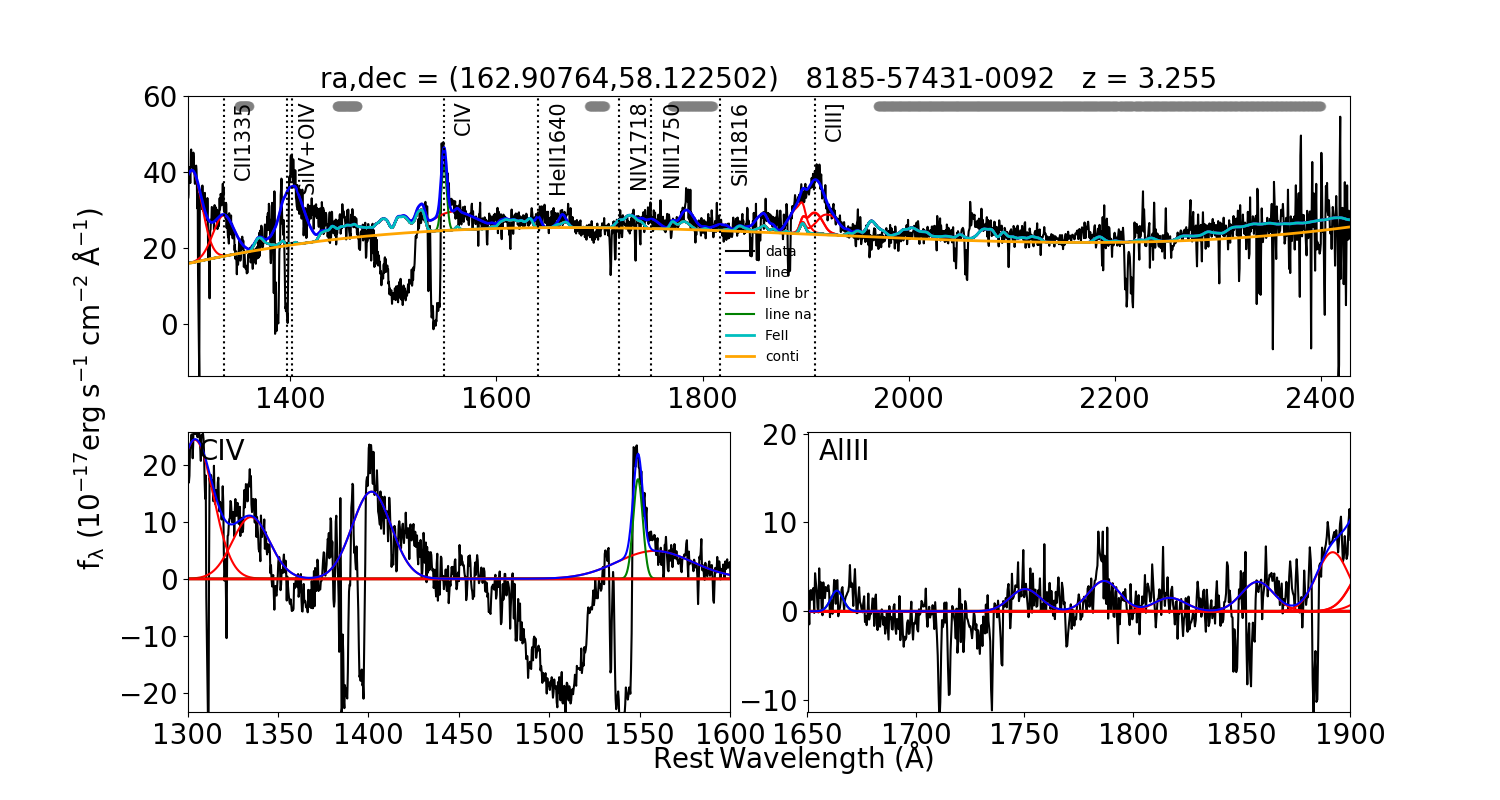PhD Intro
What are Broad Absorption Line Quasars?
Click the image below for a recent talk I gave introducing my studies to those with an astronomy and radio background. Read on for an intro based at those with no prior experience!
What is a quasar?
Black Holes in Galaxies
It is now widely accepted that at the centre of most galaxies there lies a black hole. This has been conclusively proven for our own Milky Way and recently for a nearby galaxy, M87, where the spectacular black hole image was produced last year.

We all imagine black holes as very impressive objects (which they are!) but they are incredibly small on the scale of a galaxy as a whole. For example the supermassive black hole at the centre of the milky way may be pretty big, \( \sim 4\times 10^6 M_{\odot} \), but it’s nothing compared to the total mass of the Milky Way, \( \sim 1\times 10^{12} M_{\odot} \). The moon is roughly 1% the mass of the Earth and even that a very close distance to us appears to have minimal effect (a few tides a month that are a bit bigger). So how can something that is fractionally about ten thousand times less than that be so important?
Although it has long been theorised that black holes lie at the centre of galaxies it is only relatively recently that accurate measures of the masses of black holes in other galaxies have been applicable to large samples. Astronomers have discovered an important relationship which is shown in the figure below.

What is shown here is black hole mass on the vertical axis against velocity dispersion on the right. Velocity dispersion is a statistical measure of the random velocities of stars in the bulge of the galaxy. Since the velocities of the orbits of stars depend on the gravitational potential (i.e the mass of the galaxy) this is essentially a measure of the mass of the bulge of the galaxy. We can see a strong correlation between these two parameters. Somehow galaxies and their black holes grow together. As I say this very surprising considering the fact that the black hole exerts an entirely negligible force on all of these stars.
The key question arising is what interaction between the galaxy and the black hole causes this strong correlation and in which direction is the energy transfer? Is the black hole simply bigger as their is more mass surrounding it? Is the galaxy more massive because early in its life the black hole had a much greater influence on surrounding material? Or maybe there is an interchange where energy can be transferred in towards the black hole and also outward during its evolution?
What can a black hole produce?
Well strictly speaking a black hole doesn’t emit anything (apart from Hawking radiation at an extremely low level!). I think that most people who have been exposed to at least a little bit of popular science have been told that a black hole is an object that is so dense that not even light can escape its gravitational field. This can give a picture of a sort of cold, motionless kind of object which pulls everything around it inwards until it just disappears. The reality is that this would only be the case if everything surrounding the black hole was stationary to begin with and just fell straight down towards the centre. In the real world things are already moving, generally orbiting, around the black hole. This leads to interaction between material as it falls towards the black hole with speeds close to the speed of light. The results are extreme.
Accretion
Accretion is the process by which material can spiral inwards to an object, in this case a black hole. Accretion processes usually take the form of a disk as this is the best way for a system to conseve angular momentum. Particles in the accretion disk experience friction with other particles which causes them to heat up and radiate away energy. This energy is taken from the kinetic energy and so the particles gradually spiral inwards. Orbital speed increases as the radius reduces which most of you will know from school: \[ v^2 = \frac{GM}{R} \]. As the particles get closer and closer to the black hole the temperature rises until x-rays (the highest energy photons) are being emitted very close to the event horizon.
Even though black holes themselves are not luminous they are the engines behind the most luminous objects in our universe. Astronomers have characterised the efficiency of these engines too. This is the ratio of the energy of the radiation emitted accreting material to it’s rest mass energy (\( E = mc^2 \)). They have found that black holes can range in efficiencies from 10% to 40%.
Quasars
A qausar is simply a subset of accreting black hole systemsm, this subset being the most luminous of these systems. What defines the cut from a lower luminosity black hole accretion system, known as an Active Galactic Nucleus (AGN), and a quasar isn’t very clear but astonomers usually agree on a luminosity cut when defining different sources. You can click the image below to see a simulation of a quasar.
The origin of the name quasar comes from essentially a lack of knowledge around these sources. Quasar is an abbreviation of quasi-stellar radio object. Quasars were first discovered in the 1950s as sources of radio emission. When looked at in the optical they appeared as very faint point like objects and since stars also appear as point like sources the term seemed appropriate. However, astronomers were then able to obtain the redshifts (a measure of distance) for some of these sources. They found that these were some of the most distant objects ever observed. The compactness and distance of these objects combined meant that they must be the most luminous galaxies seen too. We now know that almost all of the emission is coming from a region extremely close to the center of these galaxies which emphasises how amazing these systems are.
In the 60s when work began on understanding these sources, black holes were still considered to be only theoretical and many astronomers did not believe that they were physically realised in our universe. As studies of the systems improved it was found that in fact many quasars are not so luminous at radio frequencies, only 10% are radio loud (more on this in a future blog). Quasars are more easily identified at other wavelengths which makes their original name more outdated. The official term for a quasar is now a quasi-stellar object (QSO); the radio has been dropped! One of the great things about studying quasars is that they have signatures right across the spectrum.
Now you should have a better understanding of what a quasar, matter accreting onto a black hole, I can move to explaining the particular class I am currently studying, Broad Absorption Line Quasars.
Broad Absorption Line Quasars
Most people are familiar with the concept of spectra, the fact that light can be split into many different wavelengths which together contributed the original signal. Added to this is the concept of emission and absorption lines. These occur when the properties of different atoms either increase the signal compared to the background at certain wavelengths (emission lines) or decrease and block out emission (absorption lines).
Quasars typically show spectra that contain emission lines that have been broadened, as in they show emission at a wider range of wavelengths than the theoretical single emission wavelength for that atom.

The above image indicates how this broadenning, known as Doppler broadenning, can come about. If we have the same emitting gas but at various velocities, relative to the overall velocity of the galaxy we are looking at, then they each have a different wavelength that we observe the emission at. Overall they will combine together to produce a broadened line. The scenarios a), b), c) etc. indicate how this could occur. In the quasar scenario it is usually connected to scenario c) where the gas is orbiting. One half of the gas is moving away with respect to our observations and the other half is moving towards us, resulting in an overall broadened line.
Moving from broad emission lines to broad absorption lines is the next step to understanding the BAL appearance. When we observe the spectra of Broad Absorption Line Quasars, with an instrument such as SDSS, we see broad absorption features, next to the broad emission feature for a particular atom, but we find that this absorption is shifted to be at lower wavelengths than the emission line.

A shift to lower-wavelengths is known as a blue shift, since the blue end of the spectrum is at lower wavelengths, and is another example of Doppler shifting.
The key takeway is that this sort of feature indicates a fast moving outflow in the line of sight of our telescope.
Importance
Now we know how Broad Absorption Line Quasars can be spotted and what this indicates about outflowing gas about black holes, we can ask what the importance or signifcance is of this ouflow to the galaxy as a whole and galaxy formation history overall.

It is thought that there is enough energy in these outflowing winds to significantly effect the rate at which stars are formed in the galaxy hosting the black hole. However, there are many current unknowns that effect this signifcance. These include: how long does the BAL wind last, at what angles does the BAL wind launch, at what distance from the black hole does that BAL wind launch and many more.
In my PhD I hope to understand many more of these outstanding questions by using radio information from the LOFAR telescope to aid me.

